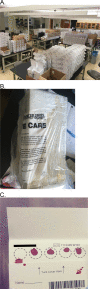Optimizing the implementation of a participant-collected, mail-based SARS-CoV-2 serological survey in university-affiliated populations: lessons learned and practical guidance
- PMID: 36224583
- PMCID: PMC9556138
- DOI: 10.1186/s12889-022-14234-1
Optimizing the implementation of a participant-collected, mail-based SARS-CoV-2 serological survey in university-affiliated populations: lessons learned and practical guidance
Abstract
The rapid spread of SARS-CoV-2 is largely driven by pre-symptomatic or mildly symptomatic individuals transmitting the virus. Serological tests to identify antibodies against SARS-CoV-2 are important tools to characterize subclinical infection exposure.During the summer of 2020, a mail-based serological survey with self-collected dried blood spot (DBS) samples was implemented among university affiliates and their household members in Massachusetts, USA. Described are challenges faced and novel procedures used during the implementation of this study to assess the prevalence of SARS-CoV-2 antibodies amid the pandemic.Important challenges included user-friendly remote and contact-minimized participant recruitment, limited availability of some commodities and laboratory capacity, a potentially biased sample population, and policy changes impacting the distribution of clinical results to study participants. Methods and lessons learned to surmount these challenges are presented to inform design and implementation of similar sero-studies.This study design highlights the feasibility and acceptability of self-collected bio-samples and has broad applicability for other serological surveys for a range of pathogens. Key lessons relate to DBS sampling, supply requirements, the logistics of packing and shipping packages, data linkages to enrolled household members, and the utility of having an on-call nurse available for participant concerns during sample collection. Future research might consider additional recruitment techniques such as conducting studies during academic semesters when recruiting in a university setting, partnerships with supply and shipping specialists, and using a stratified sampling approach to minimize potential biases in recruitment.
Keywords: Epidemiologic methods; field epidemiology; SARS-CoV-2; Serology; Serosurveys.
© 2022. The Author(s).
Conflict of interest statement
The authors have no competing interests as defined by BMC, or other interests that might be perceived to influence the results and/or discussion reported in this paper.
Figures



Similar articles
-
Effectiveness and cost-effectiveness of four different strategies for SARS-CoV-2 surveillance in the general population (CoV-Surv Study): a structured summary of a study protocol for a cluster-randomised, two-factorial controlled trial.Trials. 2021 Jan 8;22(1):39. doi: 10.1186/s13063-020-04982-z. Trials. 2021. PMID: 33419461 Free PMC article.
-
Development and Implementation of Dried Blood Spot-Based COVID-19 Serological Assays for Epidemiologic Studies.Microbiol Spectr. 2022 Jun 29;10(3):e0247121. doi: 10.1128/spectrum.02471-21. Epub 2022 May 25. Microbiol Spectr. 2022. PMID: 35612315 Free PMC article.
-
Serological surveys to estimate cumulative incidence of SARS-CoV-2 infection in adults (Sero-MAss study), Massachusetts, July-August 2020: a mail-based cross-sectional study.BMJ Open. 2021 Aug 17;11(8):e051157. doi: 10.1136/bmjopen-2021-051157. BMJ Open. 2021. PMID: 34404716 Free PMC article.
-
Serological surveys to estimate cumulative incidence of SARS-CoV-2 infection in adults (Sero-MAss study), Massachusetts, July-August 2020: a mail-based cross-sectional study.medRxiv [Preprint]. 2021 May 6:2021.03.05.21249174. doi: 10.1101/2021.03.05.21249174. medRxiv. 2021. Update in: BMJ Open. 2021 Aug 17;11(8):e051157. doi: 10.1136/bmjopen-2021-051157. PMID: 33758898 Free PMC article. Updated. Preprint.
-
High seroprevalence for SARS-CoV-2 among household members of essential workers detected using a dried blood spot assay.PLoS One. 2020 Aug 14;15(8):e0237833. doi: 10.1371/journal.pone.0237833. eCollection 2020. PLoS One. 2020. PMID: 32797108 Free PMC article.
References
-
- Mutembo S, Carcelen A, Mwansa FD, Searle K, Wanyiri JW, Book C, et al. Integrating Blood collection within household surveys: lessons learned from nesting a measles and rubella serological survey within a post-campaign coverage evaluation survey in Southern Province. Zambia Am J Trop Med Hyg. 2018;99(6):1639–1642. doi: 10.4269/ajtmh.18-0320. - DOI - PMC - PubMed
-
- Home - COVID-19 SeroHub [Internet]. [cited 2021 Dec 21]. Available from: https://covid19serohub.nih.gov/
Publication types
MeSH terms
Substances
LinkOut - more resources
Full Text Sources
Medical
Miscellaneous

